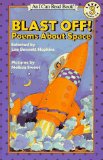It’s STEM Friday and we’re hosting this week. It’s time to soar with STEM poetry books about astronomy.
Note:Â Title links take you to more information at Amazon.
When my son was small, we discovered Blast Off: Poems About Space (I Can Read), compiled by Lee Bennett Hopkins and illustrated by Melissa Sweet (1995). The book features the poem “Children of the Sun” by Brod Bagert, which starts:
“Mercury’s small
Almost nothing at all.
Venus is bright and near…”
It was a wonderful way to memorize both a poem and the names of the planets. Of course it is slightly out of date because Pluto is no longer a planet, but many of the others in the collection are still ring true and clear.
As of today, the poems from Blast Off are available for reading on the Internet.
Out of This World: Poems and Facts about Space by Amy Sklansky and illustrated by Stacey Schuett (2012) really lives up to its name. The poems are fun, creative and absolutely perfect for kids. For example, in the poem “Zero Gravity” some of the lines are flipped over. How creative!
Each poem is accompanied by a black sidebar labeled “Fact” that explains scientific concepts or fills in the history of events that are mentioned.
You could teach a robust unit on STEM poetry with just Douglas Florian’s fabulous books. Comets, Stars, the Moon, and Mars: Space Poems and Paintings (2007) is probably the one most geared to older children.
Personally, I love Florian’s playful style and fun-filled illustrations. In this book there are cut out circles in some of the pages that move images from one page to another, some playing with changes in scale while doing so. For example, the planet Mercury is a cut out that reveals the much larger Venus on the page behind it.
And Then There Were Eight: Poems about Space (Poetry) (A+ Books: Poetry) by Laura Purdie Salas (2008) is fresh and lively. Salas is devoted to her craft, and presents poems in different forms, and then explains each in the backmatter. This book would work well for a unit on poetry as it does for a unit on space.
Although not a collection of poems, the rhyming couplets in Roaring Rockets (Amazing Machines) by Tony Mitton and Ant Parker (2000) are perfect for toddlers and preschoolers.
Are you ready to try science poetry now? Do you have any favorite poetry books about space that aren’t on the list? We’d love to hear about them!
Related activity: Exploring Space Without a Spacesuit.
Come visit the STEM Friday blog each week to find more great Science, Technology, Engineering and Math books.
















